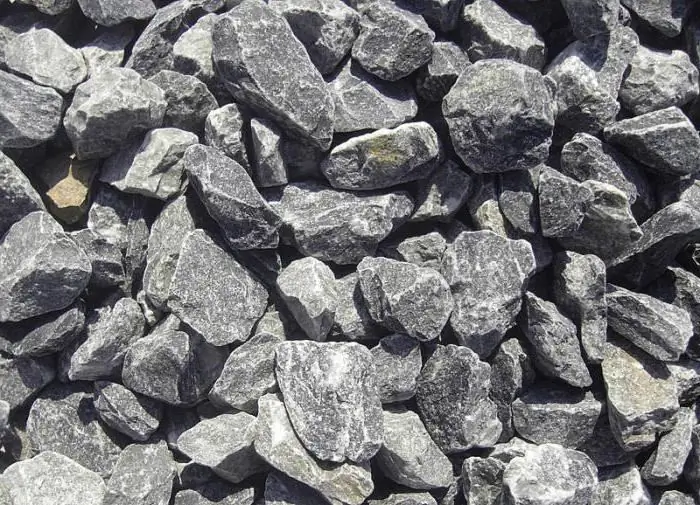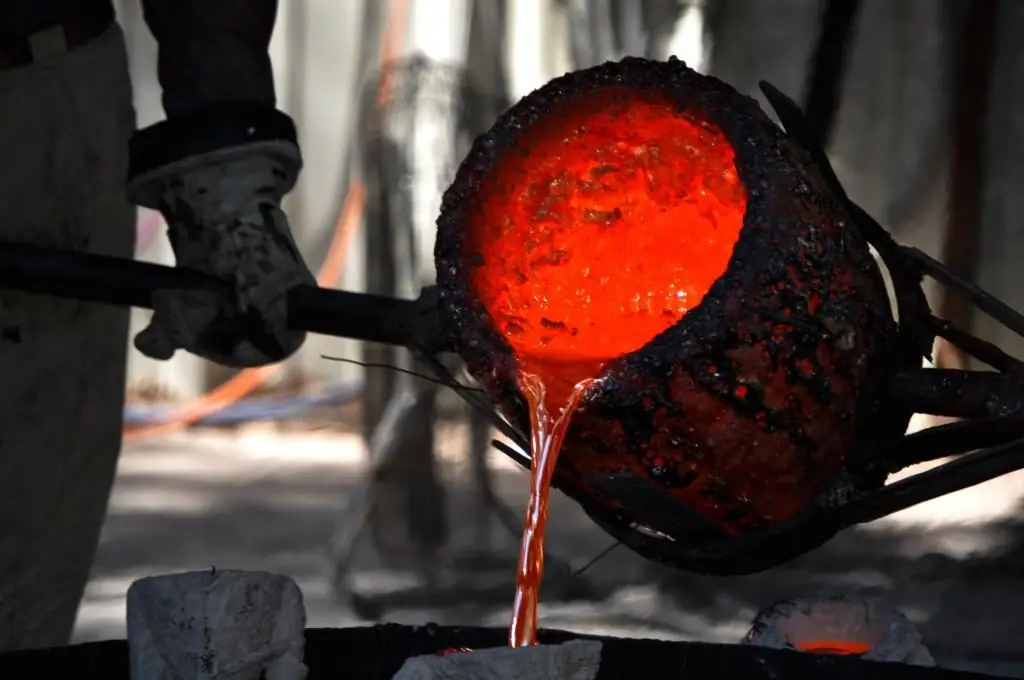2025 Author: Howard Calhoun | [email protected]. Last modified: 2025-01-24 13:10:38
Rock s alt (halite, Halite) is one of the most common minerals on earth. The chemical formula of NaCl is sodium chloride. A substance of natural origin, the main deposits are concentrated in places where in ancient times there were seas and oceans. The formation of new deposits is ongoing, s alt lakes, seas, estuaries are potential deposits. At the moment, elite grades of food s alt are mined in existing lakes, and the underlying reserves are a halite formation zone.
Origin
Halite has surface and fossil deposits. Surface deposits are divided into ancient deposits and modern formations. The ancients are mainly represented by rock s alt of sedimentary origin in the places of once-existing bays, lakes, sea lagoons during a period when the planet was dry and very hot, which caused intensive evaporation of water.
Fossil deposits occur in layers, stocks or domes below the earth's surface in a sedimentary environment. Layers of fossil s alt have a layered structure, interspersed with clay, sandstone. Dome arrangement of haliteIt is formed due to the movement of rocks, when the overlying layers, moving, push the softer deposits of rock s alt into the weakened zones, resulting in a dome. The size of the domed halite can reach several tens of kilometers.

Types of halite
The mineral halite is distinguished into primary and secondary. The primary one was formed from the brine of ancient s alt pools and has inclusions of other minerals. Secondary, later halite, formed as a result of redeposition of primary halite and is characterized by a high content of bromine.
The mineral of secondary origin has a transparent, coarse-grained structure and forms large nests in the thickness of rock s alt. During the development of deposits, large nests of halite of secondary origin are sometimes surprised by the beauty and clarity of lines, a variety of color palettes. In reservoir deposits, halite is located in the form of veins, while its structure is denser, white, sometimes the peripheral ends are colored blue, which may indicate radioactivity.

Characteristics of the mineral
Halite has a glassy luster, hardness index is 2, specific gravity of the mineral is 2.1-2.2 g/cm3. The crystals are white, grey, pink, blue, red/tint or colorless. In bulk, the nugget can be painted in several colors. Crystalline halite is soldered in three directions on any face of the cube. It occurs in nature in the form of stalactites, drusen, crystals, raids,sagging, etc.
The mineral has an ionic crystal lattice consisting of positively charged sodium ions and negatively charged chloride ions. The taste of halite is s alty, has a solid structure, completely dissolves in water, giving a precipitate of impurities, at an increased concentration precipitates in the form of crystals or flakes.

Deposits
Two of the world's largest halite deposits are located in the Volgograd region of the Russian Federation, one is located on Lake Baskunchak, the second - on Lake Elton. One of the long-discovered s alt mines is the Sol-Iletsk deposit in the Orenburg region and Usolskoye in Yakutia. Slavyano-Artemovskoye and Prekarpatskoye deposits are being developed in Ukraine.
Large reservoir deposits are located in Germany, Austria. In the US, vast halite reserves are found in Kansas, Oklahoma, and the Saskatchewan Basin in Canada.

Main scope
Halite s alt is most commonly used as a de-icing agent on roads. The climatic conditions of most of the territory of Russia are characterized by long periods of cold, atmospheric precipitation, forming an ice shell. Considering the length of motorways, no equipment is able to provide a quick cleaning of the roadway. The use of halite-based mixtures helps to quickly and effectively deal with ice and ensure traffic safety.
Technical s alt halite has advantagesare:
- Ease, versatility of use.
- Preservation of the qualities of the reagent at low temperatures (up to -30°C).
- Environmental safety.
- Low flow.
- Low cost.
- General availability.

Application Features
Treatment of the roadway with a halite-based agent provokes the formation of slurry, which destroys the ice crust tightly adhered to the asph alt. The disadvantage of the reagent can be considered the solidification of the entire mass (reagent and melted ice) at temperatures below -30 ° C.
For better road cleaning, halite s alt is mixed with sand or stone chips, which allows faster and better cleaning of asph alt from ice cover. According to the technical specifications, no more than 150 grams of s alt is required to clean one square meter of the road, which puts the mineral out of competition in comparison with other reagents. For household needs, especially in winter, you can purchase small packages of a mineral reagent. Technical s alt halite, the retail price of which varies from 5 rubles per kilogram, perfectly copes with the task.

Other uses
Technical s alt (mineral halite) is used in industry in the following areas:
- Oil production. The main property of technical halite is the dissolution of ice, the softening of frozen or hardened soil. In winter or in the conditions of the Far North, the solutionmineral s alt is pumped into the drilled wells under pressure, which greatly facilitates further work and saves other resources.
- Tableted halite is used for washing industrial boilers, heating systems in order to get rid of scale. Also, this pressed form of the mineral is used as a filter element for cleaning large volumes of water, for example, in water wells. In addition to filtration, s alt treatment eliminates the appearance of microbes and microorganisms in water. For domestic purposes, it is used to reduce the hardness of hot water.
- Construction. S alt halite is used in the production of silicate bricks to make the final product resistant to sudden temperature changes, the strength characteristics also increase and the service life is extended. Brick with s alt additive in production has a lower cost. The s alt added to the cement mortar helps it “set” faster, which speeds up the construction process and increases the durability and reliability of the building.
There are more than 14,000 areas in the world where technical s alt (halite) is used. In medicine, it is used for the production of saline solutions, antiseptics, and preservatives for medicines. Technical s alt has found application in the food industry as a refrigerant that allows you to quickly freeze and store food at the appropriate temperature.

Implementation
In the implementation, there are three types of mineral, the differences are in the characteristics:
- Top grade -the content of sodium chloride must be at least 97%, the content of foreign impurities is allowed no more than 0.85%.
- First - at least 90% calcium chloride in mass, third-party impurities - 5%.
- Second - the minimum content of the main element should be about 80%, impurities are allowed in the amount of 12% of the total mass.
The amount of moisture for any variety is regulated at a level of no more than 4.5%. The price at which technical s alt (halite) is sold depends on the grade. The price per ton of raw materials ranges from 3500-3700 rubles (in a package).
According to GOST, the storage and release of the mineral is allowed in bulk, tons, in polypropylene packages of various weights. At the same time, s alt packed in bags has a limited shelf life - up to five years, while s alt without packaging can be stored for a very long time.
Enterprises developing deposits carry out the sale of the mineral by carriage norms for wholesale buyers, which allows increasing output. According to the grade, the cost of such a mineral as s alt (halite) is also determined. The price per ton when sold by wagon rates varies from 1400 to 2600 rubles.
In addition to technical applications, halite is sold as a necessary mineral supplement for animals, in this case, the pressed mineral is produced in briquettes.
Recommended:
Types of crushed stone: description, characteristics, scope and origin

Crushed stone is a crushed stone and is divided into fractions according to its size. Technical characteristics such as flakiness, density, frost resistance, fraction, radioactivity affect the areas of use of crushed stone and its cost
Carbon is Carbon: description, scope, features and reviews

Carbon is a modern material actively used in a wide variety of industries and other areas of human life. We will talk about this most interesting product in as much detail as possible in the article
Waste rock - what is it? Description, application

In addition to minerals, the composition of mineral raw materials also includes the so-called waste rocks. What it is? Why did they get such a name? The answer to these questions will be briefly given in the article. In addition, it will briefly describe what enrichment is and describe its practical significance
Marking of bronze: characteristics, properties and scope

Due to its decorative features and many other properties, bronze has become popular. It is very difficult even for connoisseurs to name all the impurities and additives that are present in bronze alloys. This article will focus on bronze and its marking
Ductile iron: properties, marking and scope

Cast iron is a hard, corrosion-resistant, but brittle iron-carbon alloy with carbon content C ranging from 2.14 to 6.67%. Despite the presence of characteristic shortcomings, it has a variety of types, properties, applications. Ductile iron is widely used

